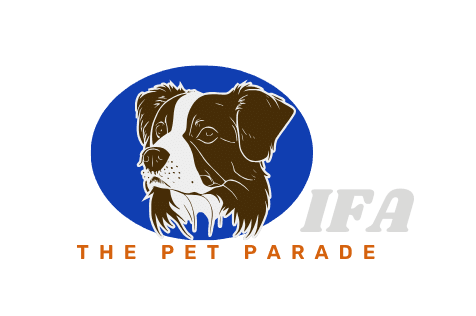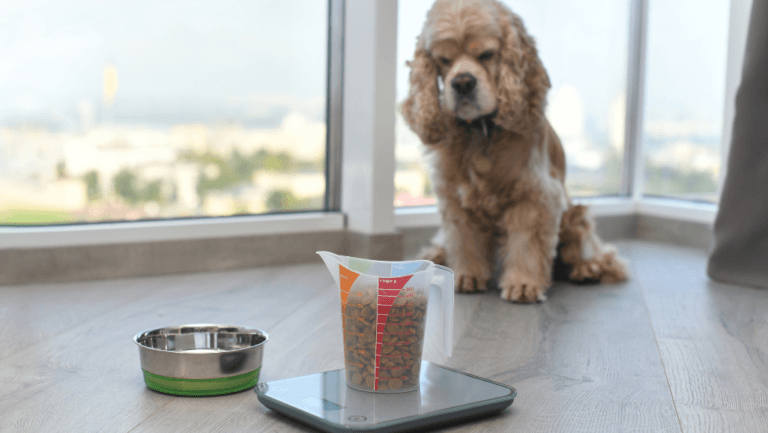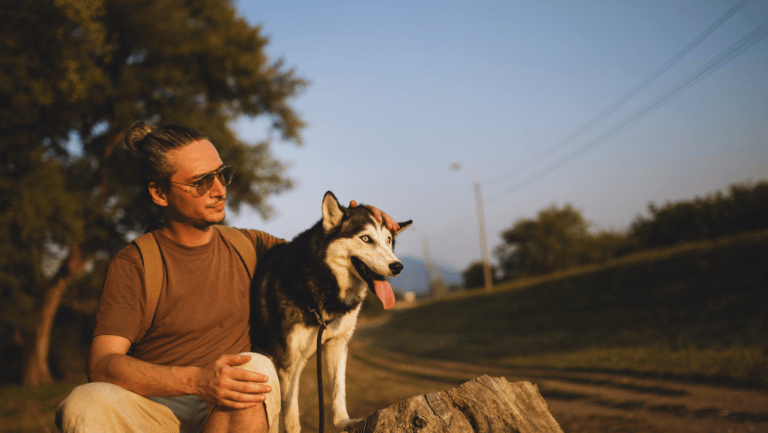According to the Association for Pet Obesity Prevention, 53% of adult dogs in the United States are affected by pet obesity. It can be difficult to assess if your pet is overweight, so it’s important to consult with your veterinarian. Signs of pet obesity include excess fat covering the ribs, lack of waist, and fat deposits on the neck and back. To help your pet lose weight, start by measuring their food intake, discouraging free feeding, and gradually increasing their exercise through walks or playtime.
Key Takeaways:
- dog obesity problems.
- Consult with your veterinarian to determine if your dog is overweight.
- Signs of pet obesity include excess fat covering the ribs, lack of waist, and fat deposits on the neck and back.
- Measuring your dog’s food intake and discouraging free feeding can help with weight loss.
- Gradually increase your dog’s exercise through walks or playtime.
- Regular veterinary check-ups are essential for monitoring weight loss progress.
Understanding the Risks of Pet Obesity
Being overweight puts dogs at risk for various medical conditions, including joint problems, such as arthritis, diabetes, heart disease, and an increased risk of certain cancers. Overweight and obese dogs also tend to have shorter lifespans and are less active and playful. It’s important to address pet obesity to ensure your dog’s long-term health and well-being.
| Risks of Pet Obesity | Complications |
|---|---|
| Joint Problems | Arthritis and reduced mobility |
| Diabetes | Increase in blood sugar levels |
| Heart Disease | High blood pressure and cardiovascular issues |
| Cancer | Elevated risk of certain types of cancer |
Canine joint health is significantly affected by excess weight. The additional stress placed on joints can lead to arthritis and reduced mobility, causing discomfort and pain for your furry friend.
Obesity also increases the risk of diabetes in dogs. Similar to humans, overweight dogs can develop insulin resistance, leading to elevated blood sugar levels and potential complications.
Heart disease is another concern for overweight dogs. The excess weight increases the workload on the heart, leading to high blood pressure and cardiovascular issues that can impact your dog’s overall quality of life.
Furthermore, canine obesity is associated with an increased risk of certain types of cancer. Adipose tissue, or excess fat, can produce hormones and inflammatory compounds that contribute to the development of cancerous cells.
Addressing pet obesity is essential to mitigate the risks and protect your dog’s long-term health. By implementing a weight loss program tailored to your dog’s needs, you can help reduce the chances of these complications and ensure a happier, healthier life for your four-legged companion.
Starting a Weight Loss Program for Your Dog
Before embarking on a weight loss program for your dog, it is essential to consult with your veterinarian to rule out any underlying medical conditions that may contribute to weight gain. Your veterinarian will play a crucial role in determining your dog’s ideal weight and creating a personalized weight loss plan. With their expertise, you can ensure that your dog’s weight loss journey is both safe and effective.
One of the key elements of a successful weight loss program is portion control. Your veterinarian may recommend feeding a weight loss diet that is specifically formulated to support healthy weight management in dogs. These diets are designed to be nutritionally balanced while providing fewer calories, ensuring that your dog receives the essential nutrients they need while promoting weight loss.
It is important to monitor your dog’s progress throughout the weight loss program. Regular weigh-ins can help you track their achievements and make any necessary adjustments to the diet or exercise routine. Your veterinarian may also suggest regular check-ups to assess your dog’s overall health and provide ongoing guidance and support.
To give you a better idea of how to implement a weight loss program for your dog, here are some pet weight loss tips:
- Follow your veterinarian’s recommended weight loss plan, including proper portion sizes and feeding frequency.
- Avoid free-feeding and establish a structured mealtime routine to help control calorie intake.
- Measure your dog’s food accurately to avoid overfeeding.
- Consider using interactive feeding toys or puzzle feeders to help slow down eating and provide mental stimulation.
- Incorporate exercise into your dog’s daily routine, gradually increasing the duration and intensity as advised by your veterinarian.
Remember, every dog is unique, and their weight loss journey may require individualized adjustments. By working closely with your veterinarian, you can develop a tailored weight loss plan that suits your dog’s specific needs.
Implementing a weight loss program for your dog requires dedication and commitment, but the rewards are immense. Helping your dog achieve a healthy weight not only improves their overall well-being but also reduces the risk of obesity-related health issues. With the guidance of your veterinarian and the right strategies in place, you can set your dog on the path to a healthier and happier life.
Incorporating Exercise into Your Dog’s Routine
Along with a balanced diet, regular exercise is essential for weight loss in dogs. Physical activity helps burn calories, improves cardiovascular health, and promotes overall well-being. Incorporating exercise into your dog’s routine can be an enjoyable and effective way to help them shed those extra pounds and maintain a healthy weight.
Here are some canine exercise tips to get you started:
- Start with daily walks: Walking is a great low-impact exercise that most dogs can easily participate in. Begin with shorter walks and gradually increase the duration and intensity over time. Aim for at least 30 minutes of brisk walking per day, depending on your dog’s fitness level and breed.
- Explore different exercise options: Depending on your dog’s breed and energy level, you can consider other forms of exercise, such as jogging, hiking, or swimming. These activities can help engage different muscle groups and provide mental stimulation.
- Make playtime a priority: Incorporate regular play sessions into your dog’s routine. Use interactive toys, such as balls or frisbees, to encourage running, jumping, and chasing. This not only provides exercise but also strengthens the bond between you and your furry friend.
For indoor cats, it’s important to provide opportunities for movement and play to prevent weight gain. Consider hiding their food around the house or using interactive toys that require physical activity to access the treats. This stimulates their natural hunting instincts and keeps them physically active.
Remember to always consider your pet’s fitness level, breed, and any existing health conditions when designing their exercise routine. If you have any concerns, consult with your veterinarian for personalized advice and guidance.
| Benefits of Regular Exercise for Dogs: |
|---|
| Burns calories and aids in weight loss |
| Improves cardiovascular health |
| Strengthens muscles and joints |
| Increases mental stimulation and reduces boredom |
| Enhances socialization skills with other dogs and people |
Choosing the Right Diet for Your Dog
When it comes to helping your dog achieve its weight loss goals, selecting the right diet is crucial. Consulting with your veterinarian will ensure that you make informed decisions based on your dog’s specific needs. Together with your vet, you can determine the best weight loss diet for your canine companion.
Weight loss diets specially formulated for dogs can provide the optimal balance of nutrients while promoting healthy weight loss. These diets take into account your dog’s calorie intake, portion control, and nutritional requirements to support their overall well-being.
Accurate food measurement is essential for successful weight loss. Be sure to follow the recommended portion sizes provided by your veterinarian, and use a measuring cup to ensure consistency and avoid overfeeding.
Monitoring your dog’s weight is key to tracking their progress. Keep a record of their weight and adjust the diet as needed to maintain a steady and healthy weight loss trajectory. Regular veterinary check-ups can provide valuable guidance and support throughout this process.
Keeping Your Dog Motivated and Preventing Overeating
Dogs can be notorious beggars, constantly eyeing that delicious human food on your plate. However, giving in to their pleading eyes can contribute to overeating and weight gain, leading to pet obesity. To help prevent this, here are some strategies to keep your dog motivated and minimize overeating:
Avoid Giving Table Scraps
While it can be tempting to share your meal with your furry friend, table scraps are often high in calories and may not provide the necessary nutrients for your dog’s balanced diet. Instead, stick to feeding them a nutritious and complete pet food that meets their dietary needs.
Limit Pet Treats
While treats can be a great way to reward and train your dog, it’s important not to go overboard. Excessive treats can contribute to weight gain. Opt for healthy, low-calorie treats and monitor the quantity to ensure they still fit within your dog’s overall daily caloric intake.
Feed Your Dog Before Your Own Meals
Feeding your dog before your own meals can help discourage begging behavior. By providing them with their mealtime first, they will be less likely to beg for your food and will have their nutritional needs met.
Establish a Routine
Dogs thrive on routine, and establishing a consistent feeding schedule can help prevent overeating. Stick to designated feeding times and avoid leaving food out all day. This will enable you to monitor their food intake and ensure they are not consuming more than necessary.
Keep Your Dog Engaged
Boredom can often lead to mindless eating in dogs. Provide mental stimulation and engage in regular playtime to keep them entertained. Interactive toys and puzzles can also help prevent boredom eating by keeping their minds occupied.
By implementing these pet obesity prevention tips and weight management strategies, you can help your dog maintain a healthy weight and overall well-being.
Monitoring Your Dog’s Progress and Maintaining Weight Loss
Regularly monitoring your dog’s weight is crucial throughout their weight loss journey. By keeping track of their progress, you can assess the effectiveness of your weight loss program and make any necessary adjustments. Weigh your dog at least once a month and record their weight to help you stay on track.
If you notice that there is no significant weight loss or your dog’s weight plateaus, it may be necessary to reassess their diet and exercise routine. Consult with your veterinarian to determine the appropriate changes that need to be made.
Veterinary check-ups are a fundamental part of maintaining your dog’s weight and overall health. Regular visits to your veterinarian will ensure that your dog remains on the right path towards their ideal weight. Your veterinarian will provide guidance and support, monitor your dog’s progress, and make any necessary adjustments to their weight loss plan.
During these check-ups, your veterinarian may conduct a thorough examination, assess your dog’s body condition score, and discuss any concerns or challenges you may be facing. They may also recommend additional tests or treatments to address any underlying health conditions that may affect your dog’s weight loss journey.
Benefits of Regular Check-ups for Your Dog’s Weight Management
Regular veterinary check-ups play a vital role in your dog’s weight management. These visits provide an opportunity for your veterinarian to:
- Evaluate your dog’s overall health and identify any underlying conditions that may contribute to weight gain or hinder weight loss.
- Monitor your dog’s progress and assess the effectiveness of their weight loss program.
- Provide tailored guidance on maintaining your dog’s ideal weight and adjusting their diet and exercise routines, if necessary.
- Address any questions or concerns you may have about your dog’s weight loss journey.
By prioritizing regular veterinary check-ups, you can ensure that your dog receives the necessary support and guidance to maintain their ideal weight and overall health.
Gauging Your Dog’s Progress: Weight Monitoring
One of the most effective ways to monitor your dog’s progress is by keeping track of their weight. You can easily do this at home using a pet scale or by visiting a veterinary clinic.
Here’s how you can monitor your dog’s weight:
| Steps for Dog Weight Monitoring | Frequency |
|---|---|
| Weigh your dog | At least once a month |
| Record their weight | After each weighing session |
| Plot the weight on a graph | Ongoing |
By tracking your dog’s weight over time, you can identify any trends and make informed decisions about their weight loss program. If you notice any sudden weight changes or abnormalities, it’s essential to consult with your veterinarian for further evaluation and guidance.
Conclusion
Pet obesity is a significant issue that can lead to various health problems in dogs. It’s essential to be aware of the risks and take action to combat it. By implementing a weight loss program that focuses on a balanced diet and regular exercise, you can help your dog achieve and maintain a healthy weight.
Long-term pet health and wellness depend on consistent efforts. Regular monitoring of your dog’s progress, tracking their weight, and making necessary adjustments to the diet and exercise routine are crucial. Don’t forget to seek the guidance and support of your veterinarian throughout the weight loss journey.
Remember, dog weight management is a long-term commitment. With patience, consistency, and the right approach, you can achieve success in canine weight loss for the overall well-being of your four-legged friend.





















